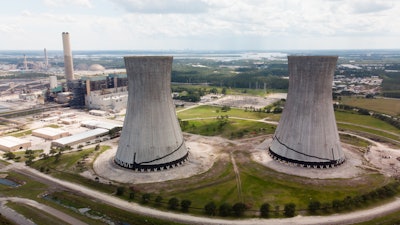
Information from this article was first published in Demolition Magazine and is being reused with permission from the National Demolition Association.
By Frank Bodami
JEA and FPL, the joint owners of the St. Johns River Power Park in Jacksonville, FL, took the park offline in January 2018 after 30 years of service. This plant was coal-fired and alternatives like solar and natural gas are becoming the choice for powering the city’s generating plants. The entire 1,600-acre park demolition is a 24-month project; the tower implosion was the first of the larger components being demolished.
While there have been other demolition projects on the site, the implosion of the twin cooling towers on June 16, 2018, was the largest project undertaken in the power park. The cooling towers were the second largest towers in the world to be imploded, standing 464 feet tall.
NDA member Total Wrecking & Environmental was shortlisted and selected through a prequalification process. Total Wrecking has three generations of demolition experience and specializes in large demolitions and environmental projects of this nature, especially for utilities and power parks.
Preparing to implode
The project commenced in April 2018, and while the tower implosions are the first major structures on the site to be taken down by implosion, many other demo activities will be taking place at the site, including asbestos abatement, powerblock demolition, coal field reclamation, ash pond remediation and site work.
Preparation of the towers where performed by use of 200,000-pound excavators with hydraulic concrete processors and grapples. This equipment was used to clear all PVC filter media and concrete supporting structures.
Prior to the implosion, Total Wrecking set up as many as five dust control machines, which are commonly known as “monsoon” machines. These machines blow streams of finely misted water up to several hundred feet high. They were setup in various locations and turned on prior to the detonation of the explosives in an effort to capture and knock dust down in place more rapidly when the dust cloud emerged from the rubble. All dust was contained in a small area of the exclusion zone, and no materials were detected outside the power park’s boundaries, which was the plan.
Close collaboration
The implosion of the cooling towers was unique in that they were the second largest cooling towers in the world to be imploded in this way. There were many layers of contractors and subcontractors to coordinate leading up to the implosion and on the day of the event.
The Jacksonville Sheriff’s Office as well as a private security firm closed the adjacent roads and performed site security well in advance of the implosion. Only credentialed implosion staff were permitted within the confines of the plant on implosion day for security reasons. Total Wrecking and implosion staff were extensively trained for their respective roles and responsibilities on implosion day and assembled in predesignated areas for head count prior to detonation of the explosives. There was an established, well-researched exclusion zone in which only Total Wrecking and implosion staff could enter.
Loading the explosives
Traditional methods were being utilized across the site for other portions of the demolition.
The inside of the cooling towers contained a PVC “honeycomb” shaped material, which are supported by concrete columns and beams. Total Wrecking had to demolish the concrete columns and beams and remove the materials for recycling in preparation for the implosion. Immediately following the interior removals, predesigned locations for the loading of explosives are carefully marked for each hole to be drilled. Hammer drills are then used to bore out holes for the insertion of dynamite. In all, 3,800 holes were necessary for this implosion.
Next, the areas of the shell where explosives will be loaded on the inside are covered with chain link fence and geotextile fabric on the outside. These activities took place over the course of the last 10 weeks. In the days leading up to the implosion, each of the 3,800 holes were loaded with varying amounts of dynamite in each hole and wired together with over 12,000 feet of detonation cord and 3,800 blasting caps. Total Wrecking and Controlled Demolition Inc. (CDI) worked together to ensure all aspects are completed expertly and on time.
The size, weight, height, proximity to other structures and public areas were all factors that were carefully considered in the design of the implosion. The location of holes is designed to cause the controlled failure of the structure, so that gravity will take over and the structure will fall in the direction intended. The placement and amount of explosives is the proprietary work of CDI and was designed to ensure failure of the structure in the intended areas with the least amount of explosives necessary to cause (but enough to ensure) structural failure. The frequency and spacing of the holes and amount of dynamite in each hole is determined in part by the thickness of the concrete and the amount of reinforcing steel. For this design, 1,500 pounds of dynamite were used in total.
Cleaning up
To date, there have been over 100 different employees of contractors and subcontractors involved in the effort. That number is expected to fluctuate and vary, ranging from 30 to 200 at any given time over the course of the entire project.
There were over 100,000 tons of concrete and nearly 4,000 tons of reinforcing steel between the two towers. The concrete was crushed into various sized construction and road base materials for re-use. Total Wrecking plans to recycle 99% of all materials derived from the demolition of the entire power park.
“Success to us is always a safe job that is done on budget and on time,” says Frank Bodami, founder and owner of Total Wrecking.
The implosion of the cooling towers on Saturday, June 16, had the added challenge of being viewed not only on-site by VIPs but across the neighborhoods by spectators outside the gates as well as the news media, which reached nationally and internationally. While all implosions are a “show,” it was very important that this implosion be safe for our workers, the attendees and the surrounding neighbors to the plant. We expected the towers to take 12 seconds to fall to the ground. In reality, it took about seven or eight seconds. Post-implosion, we started removing the materials from the site for recycling.




















